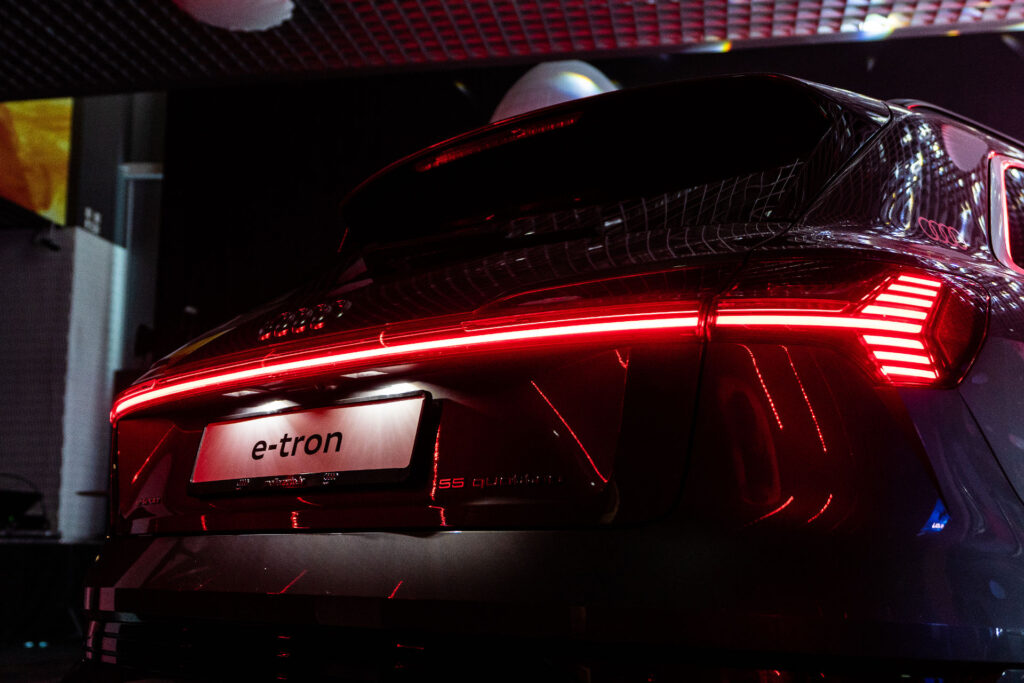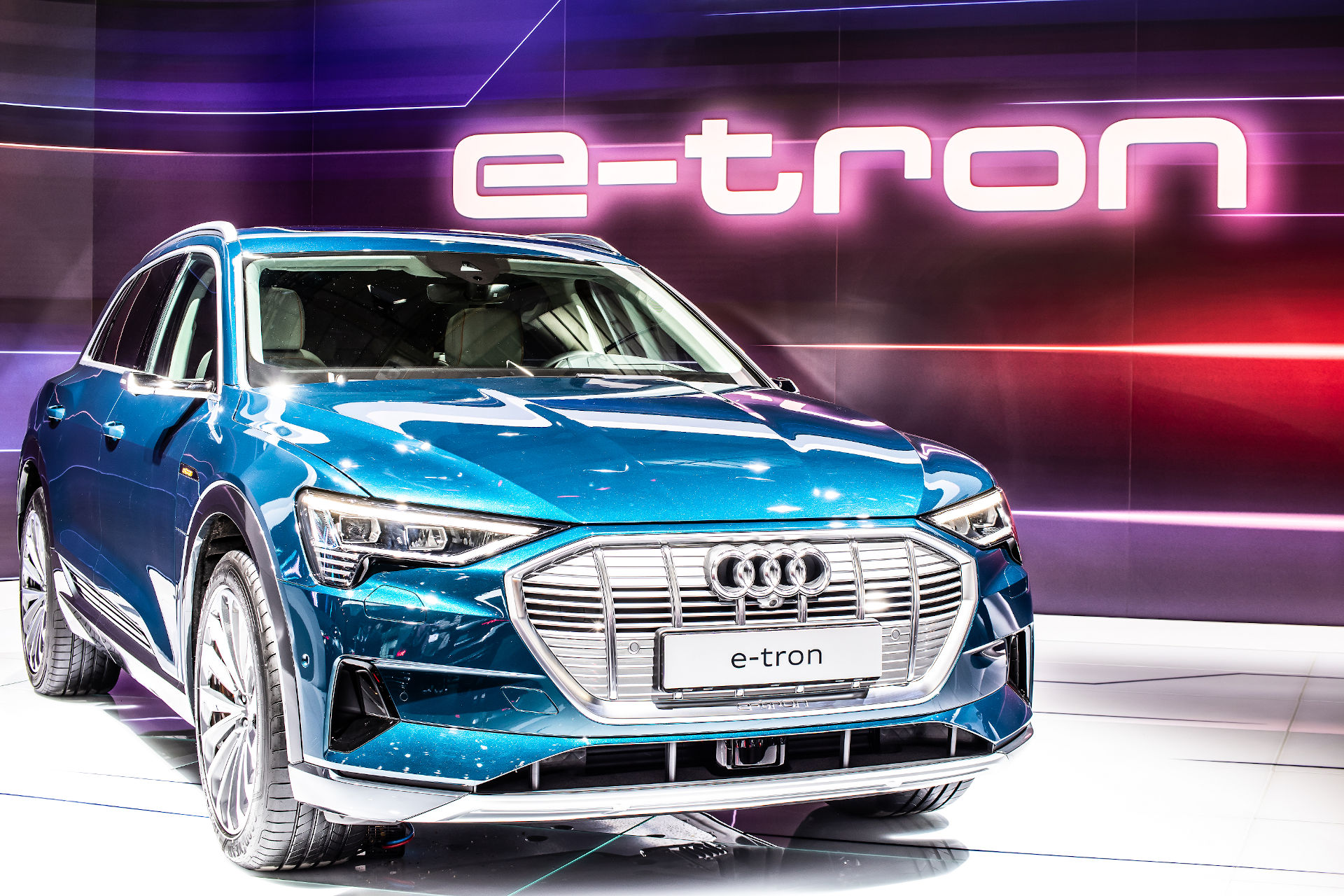The Audi e-tron has already been in production since 2019 to overseas markets.
The Audi e-tron is Audi’s first fully electric mass production car and is scheduled for arrival in Australia in the second half of 2020, along with the Audi e-tron Sportback.
The e-tron has already been in production since 2019 to overseas markets. Total sales for 2019 saw over 5,300 units sold in the U.S. and 18,000+ e-trons sold to the European market, with the highest sales figures being in Norway. Plug-in electric vehicles account for around 60% of the new car market share in the tiny Scandinavian country, thanks to Norwegian government policy which has (from as early as 1990) actively promoted the transition to electric vehicles. The e-tron is also dominating sales in the electric vehicle segment in 2020.
Audi’s marketing tactics have proven largely successful; in that they haven’t solely targeted electric vehicle buyers. Although it would seem logical to compete purely with existing fully electric vehicles, on a world scale it is still only a relatively small pool of the total car buying market.
To woo potential buyers, the majority of the Audi e-tron styling remains unmistakably Audi. At first this may seem slightly conservative, when compared to the huge step forward it represents in technology – but it has proven to be a master stroke by the design and marketing team at Audi. Making it instantly recognisable as part of the Audi SUV family, has ensured it holds appeal amongst existing Q5 and Q7 owners as well as courting first-time Audi customers who are perhaps taking the plunge to a fully electric vehicle, but maybe aren’t quite ready for the futuristic look associated with other EVs (electric vehicles). However; some of the discreet exterior design touches unique to the e-tron are the narrow light strips incorporated in each of the front and rear light assemblies, along with the distinct e-tron badges and some minor tweaks to the bonnet and front grille design.
One pioneering aspect of the e-tron that has taken the industry by storm is the inclusion of virtual mirrors as an option. This is the first time virtual mirrors have been featured on a production car and aside from increasing vision compared to a normal mirror, the exterior mirrors (cameras) also allow for a far more streamlined design, reducing wind resistance. And if history is anything to go by; it won’t be long before other manufacturers follow Audi’s lead. You don’t have to look further for examples of this design dominance than the Audi LED running lights, which were a world first when they featured on the Audi R8. An approaching Audi became instantly distinguishable at night as a result, before the look became the subject of blatant imitation by car manufacturers all over the globe (in varying degrees of taste of course).
Making it instantly recognisable as part of the Audi SUV family, has ensured the e-tron holds appeal amongst existing Q5 and Q7 owners as well as wooing first time Audi customers who are perhaps taking the plunge to a fully electric vehicle.
Is Audi’s e-tron fully electric?
The e-tron is indeed 100% electrically powered; it is so quiet that in a number of countries like the United States, an artificial driving sound is emitted through a speaker under the wheel arch at low speeds (and reverse), in order to meet safety legal requirements. Its 95 kWh (kilowatt-hour) lithium-ion battery packs some serious punch considering its Audi’s first foray into mass producing a fully electric vehicle. It does the 0-100km/h dash in 6.6 seconds (or 5.7 seconds in s, or boost) thanks to a combined 265 kW of power generated by the front and rear electric motors. (125kW from the front motor and 140kW from the rear unit.) To maximise efficiency though, the rear electric motor will do most of the work in everyday driving, but Audi’s electric four wheel drive technology will respond in the time it takes you to blink, activating the front electric motor as additional power and traction are required.
A key advantage of the Audi e-tron being fully electric is that without a conventional engine under the bonnet, weight distribution equates to almost 50/50 over each axle. Having the battery pack located between the front and rear wheels markedly improves the handling characteristics of this SUV, giving more of that sport sedan feel – despite the e-tron weighing in at a hefty 2490 kilograms. Obviously, the air spring suspension plays a huge role as well, in the superb way it is able to individually raise or lower each corner of the car during cornering, all dependant on how late the driver might be for his or her particular appointment and the resulting driving style.
The Audi e-tron features an energy recovery system that is activated when the foot is taken off the accelerator as well as during braking which increases the range covered prior to charging. Depending on how hard the brake pedal is pressed, the initial braking felt will be the electric motors at work; once this braking force exceeds certain parameters, the wheel brakes are also activated to bring the vehicle to a stop in the quickest possible time if needed.
Despite these energy-saving factors not giving the e-tron record-breaking range figures compared to other fully electric vehicles, Audi’s intention is that the reliability of the vehicle will be the drawcard for people expecting maintenance costs comparable to an internal combustion engine. Prioritising longevity and reliability are also in line with the customer base Audi is targeting, with range being set at a less ambitious figure to achieve this. In theory, Audi could reconfigure the vehicle to draw extra range from walled off battery reserves, but this would potentially come at the cost of product quality – a virtue synonymous with the marque’s reputation that has been built up over decades.

Audi’s e-tron is built in Brussels, the capital region of Belgium.
Other features that Audi drivers would be familiar with are elements the e-tron shares with the rest of the Audi line up. The quality of the interior materials is a perfect example – being second to none, as is to be expected; this includes the leather seats, with comfort levels Audi owners swear by, as well as the plush finish of the doors and dashboard, complete with chrome accents worthy of a car in the luxury vehicle class. Driver controls and displays are reassuringly familiar, save the extra touch screen for adjusting the air conditioning. The typical Audi Multi Media Interface doesn’t deviate greatly from other Audis in terms of functionality, but does include additional sub-menus to enhance oversight of the electrical aspects of the e-tron, such as battery charge status.
In theory, Audi could reconfigure the vehicle to draw extra range from walled off battery reserves, but this would potentially come at the cost of product quality – a virtue synonymous with the marque’s reputation that has been built up over decades.
Where is the Audi e-tron Made?
The Audi e-tron is built in Brussels, the capital region of Belgium. The Brussels manufacturing plant has a long history with the automotive industry, dating right back to the late 1940s. Established as an independent car manufacturing plant in 1949 by Pierre D’leteren, the plant had assembled around 800,000(!) Volkswagen Beetles under licence by 1970. In more recent times – the plant changed its name to Audi Brussels in 2008, focusing on the production of the Audi A1, and as of 2018 has been exclusively producing the fully electric e-tron.
Cost of Audi e-tron in Australia
There isn’t an exact dollar figure on the price of an Australian delivered e-tron, but early estimates were around the $120,000 mark. The original listed sales price for the Audi e-tron in Germany was 79,900 Euros, which equates to around 140,000 Australian dollars at the current exchange rate. In certain markets there is also the option for customers who have pre-ordered an e-tron, to purchase the ‘Audi e-tron Edition One’ an exclusive options pack; loaded with extras.
Why Are Electric Cars So Expensive?
The expenses associated with the main components in a fully electric car pass from manufacturer to consumer in the form of the initial sale price. EV specific items such as the battery pack and the electric drive units, cost vastly more than their conventional counterparts. In addition, electric cars have far more componentry as a whole, including modules, sensors, and circuitry, which influence the overall purchase price of an EV.
Electric cars are definitely the direction in which the collective automotive industry is headed. For the moment, initial purchase price of electric cars remains fairly pricey, despite governments of countries like Norway throwing incentives around like confetti; government initiatives are often in the form of rebates but also include offers such as free parking and use of express lanes in peak hour, to promote the purchase of environmentally friendly vehicles.
As with all new and limited technology, it is expensive early on. But as research and development advancements are made, technology will improve and become more available, leading to an increased competition between the various EV manufacturers, making it a more varied and competitive market than it is today. But to make a fair price comparison, it is important to look past the initial purchase cost and weigh it up against other factors like petrol or diesel savings over time.
Are Electric Cars Cheaper to Maintain?
As a very general rule, electric cars are cheaper to run, purely for the fact that there are fewer rotating parts. However, the ever-increasing scopes that new car warranties cover, like seeing capped maintenance costs getting bundled into purchase contracts means it may not be relevant for the first period of ownership. On offer is everything from x amount of years/kilometres warranty from the different brands extending to free or capped price servicing and repairs throughout some or all of the warranty period. This is probably one of the first things to look at when comparing an electric car to its petrol, diesel, or hybrid equivalent, plus any potential maintenance expenses that are excluded in the fine print.
Secondly; when calculating maintenance costs, duration of ownership is probably the most essential element of the maintenance equation. If you are purchasing a used car, or intend to keep it beyond the warranty period, it definitely pays to do some due diligence regarding maintenance costs associated with EVs.
Clearly, there are many expensive maintenance costs associated with petrol and diesel engines which are eliminated when making the switch to a fully electric vehicle. Major service and repair items such as timing belts, water pumps and the dreaded head gasket failure are no longer relevant. As are the headaches associated with diesel car ownership, namely the absurdly expensive fuel injectors and diesel particulate filter;, just to mention a couple.
At face value, maintenance costs connected to pre-owned electric vehicles are relatively lower than their gas guzzling relatives. But as with every used car purchase, there are certain pitfalls to avoid. Despite having an advertised predicted lifespan, real life durability of individual components like battery packs can vary considerably. Other items subject to wear and tear, be they tyres or suspension components, will still require maintenance just like they always have.
So overall, though there will be less money spent in the sense of zero oil changes, it is still a good idea to have some money set aside for a rainy day. Because in life, there’s always the chance of something going wrong when least expected – even with an electric vehicle.
Information and advice in this article is general in nature and current at the time of publication, and no warranty is offered as to its accuracy or completeness.


